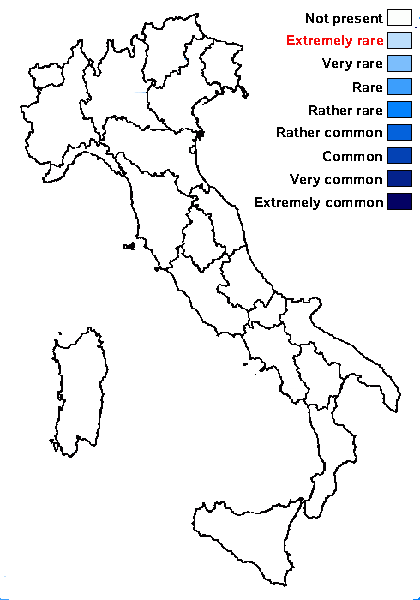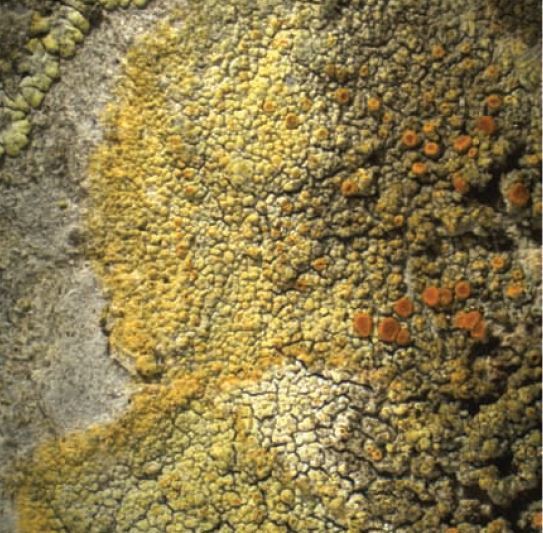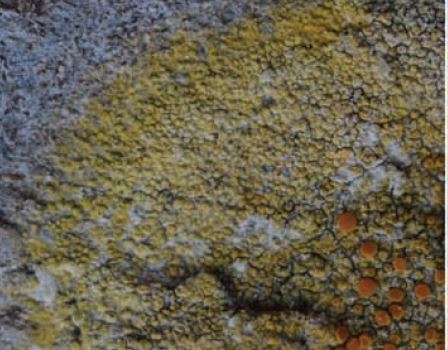Coppinsiella fiumana (Zahlbr.) I.V. Frolov
in Frolov & al., Phytotaxa, 549, 2: 224, 2022. Basionym: Caloplaca fiumana Zahlbr. - Ann. K. K. naturh. Hofmus. Wien, 25: 248, 1911.
Synonyms:
Distribution:
Description: Thallus crustose, episubstratic, areolate, bright orange-yellow, lemon-yellow, ochre-yellow or orange, rarely white, often with a brighter yellow, 1-1.5 mm wide marginal zone, forming orbicular, (5-)13-18(-37) mm wide patches, several thalli often merging to cover larger areas, often rimmed by a thin white to light orange, fimbriate prothallus. Areoles angular or rounded, (0.1-)0.2-0.6(-1) mm in diam., flat to convex, often granular at thallus margin, the granules (0.04-)0.08–0.22(-0.35) mm wide; central areoles often forming (0.4-)0.8-1.8(-3) mm thick, raised tufts with a thicker medulla. Cortex conspicuous, even, often with gaps resulting from dead algal cells, (10-)20-26(-42) µm high, formed of 3-7 layers of thin-walled isodiametrical cells, usually with large, more or less isodiametrical crystals of calcium oxalates; epinecral layer yellow-brown, (3-)6-13(-30) µm thick; medulla usually conspicuous (10-)17-28(-38) µm thick, formed by a prosoplectenchymatous tissue of thin-walled hyphae, with minute crystals. Apothecia often abundant, zeorine, at first immersed, becoming adnate to sessile, (0.3-)0.5-0.7(-1.1) mm across, with a flat to convex, orange, epruinose disc, a yellow to orange, paler, raised thalline margin, and an orange proper margin forming a parathecial ring. Thalline exciple (14-)40-54(-120) µm wide, corticate, formed of isodiametrical to elongated thin-walled cells; proper exciple (16-)27-47(-75) µm wide, colourless within, formed by thin-walled, almost isodiametrical cells in the uppermost part, of palisade prosoplectenchyma with thin-walled cells in lower part; epithecium yellow-brown, covered in colourless granular crystals, K+ purple-red; hymenium colourless, (50-)76-96(-150) µm high, inspersed with oil droplets; paraphyses usually branched, containing oil droplets, (1.5-)2(-4.5) µm thick in lower part, the apical cells (3.5–)5.5–8(–10) µm wide; hypothecium colourless. Asci 8-spored, clavate, functionally unitunicate, apically thickened with a broad internal beak, the inner part of apex and external cap I+ blue, Teloschistes-type. Ascospores 2-celled, polarilocular, hyaline, ellipsoid or rarely partly rhomboid, (7.5-)10-13.5(-16) x (2.5-)5-7(-10) µm, the equatorial thickening (“septum”) (2.5-)4.5-6(-7.5) µm. Pycnidia common, mostly marginal, forming brighter yellow-orange spots. Conidia ellipsoid, straight or rarely slightly curved or tear shaped, rarely bacilliform, (2-)3-3.5(-5) x (1-)1.7-2.2(-3.0) µm. Photobiont chlorococcoid. Spot tests: thallus and apothecia K+ purple-red, C-, KC-, P-. Chemistry: parietin (major), emodin, fallacinal, parietinic acid and teloschistin (minor or traces).Note: on steeply inclined, rather shaded, rain-protected surfaces of calcareous rocks. Described from Fiume (Croatia) and known from several sites in Central Europe; to be looked for in Italy.
Growth form: Crustose
Substrata: rocks
Photobiont: green algae other than Trentepohlia
Reproductive strategy: mainly sexual
In underhangs rarely wetted by rain
Commonnes-rarity: (info)
Alpine belt: absent
Subalpine belt: absent
Oromediterranean belt: absent
Montane belt: absent
Submediterranean belt: absent
Padanian area: absent
Humid submediterranean belt: absent
Humid mediterranean belt: absent
Dry mediterranean belt: absent

Predictive model
Growth form: Crustose
Substrata: rocks
Photobiont: green algae other than Trentepohlia
Reproductive strategy: mainly sexual
In underhangs rarely wetted by rain
Commonnes-rarity: (info)
Alpine belt: absent
Subalpine belt: absent
Oromediterranean belt: absent
Montane belt: absent
Submediterranean belt: absent
Padanian area: absent
Humid submediterranean belt: absent
Humid mediterranean belt: absent
Dry mediterranean belt: absent

Predictive model
 INDEX FUNGORUM
INDEX FUNGORUM
 GBIF
GBIF



